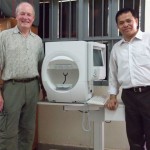|
|


The Rose Charities Eye Clinic in Phnom Penh has just received a major boost, with the arrival of high-tech equipment donated from the New Zealand optom community and a visit from Rose Trustee optometrist Mike Webber with technician Neville Wood.
Three instruments were air-freighted up early this year with the help of one of the Rose team’s guardian angels, Agility Logistics of Lower Hutt. Other benefactors, the PIF Foundation, Peter and Sylvia Aitchison, Sidonia and Adam Pertschy (of Germany ), Mrs Angela Aitken and Mrs Sue Forrest, met the cost of freight and air fares for Mike and Neville.
The three instruments are a Millenium Phaco machine used in cataract surgery, donated by Christchurch’s St Georges Hospital; a Humphrey Field Analyser used for early detection of conditions like glaucoma which cause blindness, donated by the Eye Department, Whanganui Hospital, and an autoclave donated by Alpha Technical Services, of Palmerston North.
As well, a chance encounter with a millionaire “refugee” from New York during the recent visit to Phnom Penh by Rose General Secretary Dr Will Grut has led to a $US17,000 YAG laser being given to the clinic.
The high-level equipment is in the good hands of the medical director Dr Hang Vra, who has just completed his postgraduate ophthalmology exams with top honours, and his wife Nathalie, who is topping her class as she completes her medical degree, having trained as a nurse in the Ukraine.
“Vra and Natalie have both done so well with their studies, while they work so hard for the hundreds of patients who arrive at the clinic every week,” said Mike Webber. “It is really rewarding for them and all the Rose supporters to see the first-class equipment in place.” With these latest instruments the clinic has everything it needs for the foreseeable future.
But changes are afoot. During Mike’s visit an early morning blessing ceremony was held before work begins on a new building that will become both home for Vra and Nathalie and their three sons and a new clinic where paying patients will be treated.
“In Cambodia, you don’t talk about private and public,” says Mike. “It is rich and poor. Vra will earn more money to educate his sons by establishing this new clinic. But he and Nathalie are totally committed to helping the poor as well. I feel confident the balance between their new clinic and the existing one will work out well.
“Things are rapidly changing in Cambodia, and already the city boundary has been extended past the section owned by Nathalie, which is about 15kms north of the present clinic along the main road to Siem Riep.
“So in all I believe that Rose NZ can be proud of what has been achieved over the past six years at the clinic. It is now running splendidly, with
good outcomes for the patients, and I believe that Vra and his team are running the show very well with less input from us as time goes on. They
will still need the occasional input and advice over time, but it wiil get less as their expertise increases. They are all so grateful for all the support from Rose Charities, both from Canada and New Zealand.”